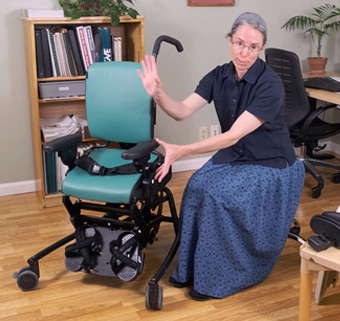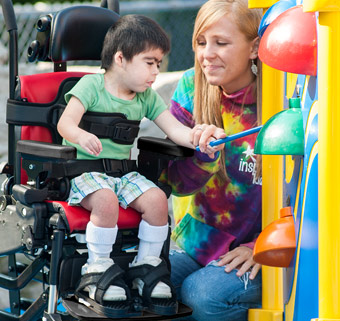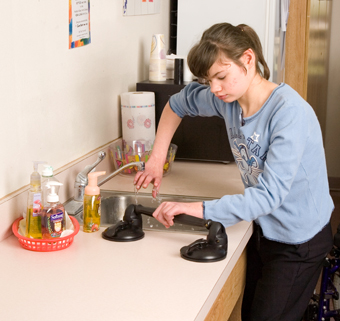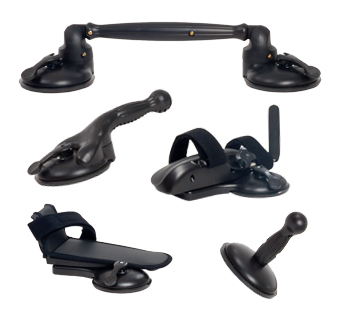Using the Rifton Activity Chair with Forearm Prompts
| September 2025 For people with neuromotor disabilities, learning to sit actively opens the door to increased independence and meaningful participation in daily activities. Unlike passive, reclined, or relaxed sitting, active sitting positions a person to activate their core muscles and stabilize their head and trunk. This positioning enables individuals to use their arms and hands more effectively to reach, eat, and communicate. It also improves breathing and provides better visual stability for peer interaction.
For people with neuromotor disabilities, learning to sit actively opens the door to increased independence and meaningful participation in daily activities. Unlike passive, reclined, or relaxed sitting, active sitting positions a person to activate their core muscles and stabilize their head and trunk. This positioning enables individuals to use their arms and hands more effectively to reach, eat, and communicate. It also improves breathing and provides better visual stability for peer interaction.
Key components of active sitting include pelvic stability and alignment, and good foot contact with the floor or a footboard. This provides a foundation for anterior tilt of the seat to cue muscle activation and upright postures, and adjustment of seat-to-back angles for active trunk control and seating of the pelvis. Additional supports for leg, head, and trunk alignment are provided as needed.
The Rifton Activity Chair offers these features and positioning options for developing sitting skills. A particularly valuable feature of the Activity Chair is the forearm prompts.
Active Sitting with Forearm Prompts
 The forearm prompts are not the same as armrests, which come standard with all Activity Chairs and provide lateral support and boundary-setting. Rather, the forearm prompts are specifically designed to position an individual in a forward-leaning, engaged position.
The forearm prompts are not the same as armrests, which come standard with all Activity Chairs and provide lateral support and boundary-setting. Rather, the forearm prompts are specifically designed to position an individual in a forward-leaning, engaged position.
With a slightly upward-angled “L”-shaped metal frame and soft supports for the arms, the forearm prompts insert directly into the slots of the armrests. They guide the individual’s arms to the front of the body while simultaneously providing a stabilizing surface. This allows the person to lean forward, tilting the pelvis anteriorly, and initiating a chain reaction that stabilizes the core and activates the muscles supporting the trunk and head. Additionally, as the pelvis moves into anterior tilt, the center of gravity shifts forward, cuing the feet to push through the footboard and initiate weight acceptance. Combining the forearm supports with anterior tilt-in-space of the seat amplifies this effect as a progression of advanced sitting skills. While a tray attached to the Activity Chair can provide support for the upper extremities, the forearm supports provide precise positioning and upward angling of the forearms.
Rifton Activity Chair Forearm Prompts and the MOVE™ Program
 The concept of the forearm prompts stems from the Advancement Chair concept of the MOVE program. MOVE, or Mobility Opportunities Via Education, is a program designed to teach the functional skills of sitting, standing, walking, and transitioning during everyday routines to people with severe disabilities. In traditional seating approaches, many individuals with disabilities spend much of their day in wheelchairs which offer comfortable and secure positioning, often reclined, with minimal opportunities to challenge or improve sitting ability. The Rifton Activity Chair and the MOVE program transform seating into a motor skill and learning opportunity with the potential to increase independence and participation. The forearm prompts along with all the other features and components of the Rifton Activity Chair help to challenge and progress an individual toward independent seating.
The concept of the forearm prompts stems from the Advancement Chair concept of the MOVE program. MOVE, or Mobility Opportunities Via Education, is a program designed to teach the functional skills of sitting, standing, walking, and transitioning during everyday routines to people with severe disabilities. In traditional seating approaches, many individuals with disabilities spend much of their day in wheelchairs which offer comfortable and secure positioning, often reclined, with minimal opportunities to challenge or improve sitting ability. The Rifton Activity Chair and the MOVE program transform seating into a motor skill and learning opportunity with the potential to increase independence and participation. The forearm prompts along with all the other features and components of the Rifton Activity Chair help to challenge and progress an individual toward independent seating.
Configure and get a quote for the Rifton Activity Chair.
Learn more about active sitting:
Learn more about MOVE:





